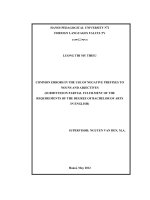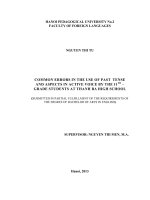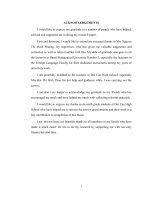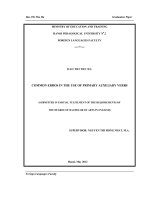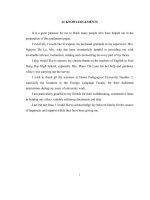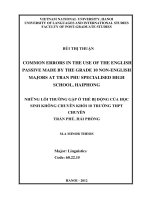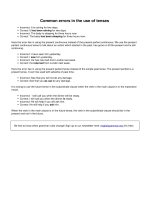Common errors in the use of primary auxiliary verbs
Bạn đang xem bản rút gọn của tài liệu. Xem và tải ngay bản đầy đủ của tài liệu tại đây (370.25 KB, 65 trang )
Dao Thi Thu Ha
Graduation Paper
MINISTRY OF EDUCATION AND TRAINING
HANOI PEDAGOGICAL UNIVERSITY N0.2
FOREIGN LANGUAGES FACULTY
==***==
DAO THI THU HA
COMMON ERROS IN THE USE OF PRIMARY AUXILIARY VERBS
(SUBMITTED IN PARTIAL FULFILMENT OF THE REQUIREMENTS OF
THE DEGREE OF BACHELOR OF ARTS IN ENGLISH)
SUPERVISOR: NGUYEN THI HONG NHAT, M.A.
Hanoi, May 2012
Foreign Languages Faculty
Dao Thi Thu Ha
Graduation Paper
ACKNOWLEDGEMENTS
I would like to express great gratitude to my supervisor, Nguyen Thi Hong
Nhat, M.A., for her invaluable support and masterful guidance throughout the process
of writing this thesis.
My sincere thanks are expressed to all lectures of Foreign Languages Faculty at
Hanoi Pedagogical University N0.2 for their valuable knowledge, and advice during
my study.
I would like to thank to all the first year English major students of Foreign
Languages Faculty for their cooperation, which contributes to my successful thesis.
My deep love and special gratitude are also my beloved parents for teaching
me, and giving me support, advice, and love that help me to accomplish this thesis.
Furthermore, I would like to thank my close friends who never stop
encouraging me to finish my thesis.
Foreign Languages Faculty
Dao Thi Thu Ha
Graduation Paper
ABSTRACT
It cannot be denied that English is one of the most popular and important
languages in the world. Since it becomes an international language, English covers
most aspects of social life such as education, economy, and technology. However,
many people agree that English has a very complicated grammatical system and it
causes many difficulties for students who learn English as foreign language (EFL),
especially Vietnamese students.
Inspired from the reality, the study is carried out on fifty first- year English
major students of Foreign Languages Faculty at Hanoi Pedagogical University N0.2 to
investigate the students’ knowledge of primary auxiliary verbs and find out common
errors in the use of this kind of verb.
Based on results of survey, common errors in the uses of primary auxiliary
verbs are analyzed clearly. There are seven main types of errors, which the students
make on doing exercises. Among them, percentage of errors in the use of “have” in
structure “have + subject + verb form” is highest; meanwhile the propotion of errors
in the use of “do” to avoid repetition is lowest.
With the strong hope that the study will help the students to reduce their errors,
the researcher proposed some useful techniques. Then, limitations of the thesis and
suggestions for further study are also mentioned.
Foreign Languages Faculty
Dao Thi Thu Ha
Graduation Paper
STATEMENT OF AUTHORSHIP
Title:
COMMON ERRORS IN THE USE OF PRIMARY AUXILIARY VERBS
(Submitted in partial fulfillment of the requirements for Degree of Bachelor of Arts in English)
I certify that no part of this report has been copied from any other person’s
work without acknowledgements and that the report is originally written by me under
instructions of my supervisor.
Date submitted: April 2012
Student
Supervisor
DAO THI THU HA
NGUYEN THI HONG NHAT, M.A.
Foreign Languages Faculty
Dao Thi Thu Ha
Graduation Paper
TABLE OF CONTENTS
Acknowledgments ..................................................................................................... ii
Abstract .................................................................................................................... iii
Statement of authorship .......................................................................................... iv
Table of contents .......................................................................................................v
List of tables and figure........................................................................................... ix
List of abbreviations ..................................................................................................x
PART ONE
INTRODUCTION
Rationale .................................................................................................................. 1
Research objectives ................................................................................................ 2
Research scope ........................................................................................................ 2
Research tasks ........................................................................................................ 2
Research methods ................................................................................................... 3
Research significance .............................................................................................. 3
Research design ...................................................................................................... 4
PART TWO
DEVELOPMENT
CHAPTER ONE: LITERATURE REVIEW
I.1. Literature review in brief................................................................................. 5
I.2. Auxiliary verbs .................................................................................................. 5
I.2.1. Definition ......................................................................................................... 5
I.2.2. Characteristics ................................................................................................. 7
Foreign Languages Faculty
Dao Thi Thu Ha
Graduation Paper
I.2.3. Classification.................................................................................................... 9
I.3. Primary auxiliary verb ................................................................................... 10
I.3.1. Forms and the uses of “Be” ........................................................................... 10
I.3.1.1. Forms .......................................................................................................... 10
I.3.1.2. “Be” as an auxiliary verb ............................................................................ 11
I.3.1.2.1. “Be” is used in formation of progressive forms ..................................... 11
I.3.1.2.2. “Be” is used in the formation of passive voice........................................ 11
I.3.1.2.3. “Be” is used in the structure “Be + infinitive verb” ................................ 12
I.3.1.2.4. “Be” is used in structures “Be about + infinitive verb”........................... 12
I.3.1.3. “Be” as an ordinary verb ............................................................................. 13
I.3.2. Forms and the uses of “Have” ....................................................................... 13
I.3.2.1. Forms .......................................................................................................... 13
I.3.2.1. “Have” as an auxiliary verb ........................................................................ 14
I.3.2.1.1. “Have” is used in formation of perfect tenses ......................................... 14
I.3.2.1.2. “Have” is used to make questions and negatives .................................... 14
I.3.2.1.3. “Have” is used in structure “Have + V_ infinitive” ................................ 15
I.3.2.2. “Have” as an ordinary verb ......................................................................... 15
I.3.2.2.1. “Have” is used to show possession .......................................................... 15
I.3.2.2.2. “Have” is used to express actions and experiences ................................. 16
I.3.2.2.3. “Have” is used in structure “Have + object + verb form” ....................... 16
I.3.2.2.4. “Have” in questions and negatives .......................................................... 17
I.3.2.2.5. Double form “have got”........................................................................... 17
I.3.3. Forms and the uses of “Do” ........................................................................... 18
I.3.3.1. Forms .......................................................................................................... 18
I.3.3.2. “Do” as an auxiliary verb............................................................................ 18
I.3.3.2.1. “Do” is used in the negative .................................................................... 18
I.3.3.2.2. “Do” is used in interrogative ................................................................... 18
Foreign Languages Faculty
Dao Thi Thu Ha
Graduation Paper
I.3.3.2.3. “Do” is used in emphasis ......................................................................... 19
I.3.3.2.4. “Do” is used in imperative ....................................................................... 19
I.3.3.2.5. “Do” is used to avoid repetition............................................................... 20
I.3.3.3. “Do” as an ordinary verb ............................................................................ 20
I.3.4. Comparison modal auxiliary verbs with primary auxiliary verbs ........ 20
CHAPTER TWO: METHODOLOGY, RESULTS, DISCUSSION,
AND SUGGESSTED SOLUTIONS
II.1. Methodology .................................................................................................. 23
II.1.1. Research questions ....................................................................................... 23
II.1.2. Participants ................................................................................................... 23
II.1.3. Data collection ............................................................................................. 24
II.1.3.1. Procedure ................................................................................................... 24
II.1.3.2. Instrument ................................................................................................. 25
II.1.4. Data analysis ................................................................................................ 26
II.2. Results ............................................................................................................ 27
II.3. Discussion ....................................................................................................... 28
II.3.1. Answer to research question 1...................................................................... 28
II.3.2. Answer to research question 2 ..................................................................... 29
II.3.2.1 Errors in the use of “have” in structure “have + object + verb” ................ 29
II.3.2.2. Errors in the use of “do” in emphasis ........................................................ 30
II.3.2.3. Errors in the use of “be” in passive voice ................................................. 30
II.3.2.4. Errors in the use of “be” in progressive form............................................ 31
II.3.2.5. Errors concerning subject- verb agreement ............................................... 31
II.3.2.6. Errors of confusion between auxiliaries and ordinaries ........................... 32
II.3.2.7. Errors in the use of “do” to avoid repetition ............................................. 33
II.4. Suggested solutions to the problems ........................................................... 33
Foreign Languages Faculty
Dao Thi Thu Ha
Graduation Paper
II.4.1. Suggested solutions ..................................................................................... 33
II.4.2. Suggested exercises ...................................................................................... 35
II.4.2.1. Suggested sources for primary auxiliary verb exercises ........................... 35
II.4.2.2. Suggested types of exercises ..................................................................... 35
II.4.2.3. Samples of exercises.................................................................................. 36
PART THREE
CONCLUSION
CONCLUSION ..................................................................................................... 40
REFERENCES
APPENDIX 1
APPENDIX 2
APPENDIX 3
Foreign Languages Faculty
Dao Thi Thu Ha
Graduation Paper
LIST OF TABLES
Table 1: Forms of primary auxiliary verb “be” ..................................................... 10
Table 2: Forms of primary auxiliary verb “have” ................................................. 13
Table 3: Forms of primary auxiliary verb “do” ..................................................... 18
Table 4: Percentage of errors in the use of primary auxiliary verbs .................... 27
Table 5: Marks and level of the students ................................................................ 28
LIST OF FIGURE
Figure 1: The performance of the students on primary auxiliary verbs ................ 29
Foreign Languages Faculty
Dao Thi Thu Ha
Graduation Paper
LIST OF ABBRIVIATIONS
EFL: English as foreign language
ESL: English as second language
Foreign Languages Faculty
Dao Thi Thu Ha
Graduation Paper
PART ONE
INTRODUCTION
Rationale
Language is not only a very important medium of communication, which helps
people to express their ideas and feelings, but it is also used for many other special
purposes. It is thought that there are more than 6,000 languages in the world and
English is one of the most widely spoken languages. It cannot be denied that learning
English is very crucial because it is considered as an international language and used
in many fields such as in economy, education, science and technology.
The English language has an official status even in nations where it is not the
primary spoken language. In Vietnam, with the development of science, education,
knowledge- based economy; more and more people are learning English. In addition,
English is also taught as a compulsory subject at schools as well as universities.
However, because of the differences of grammar system between English and
learners’ native language, English causes many difficulties for learners. Vietnamese
learners, who study English as a foreign language, are not the exception and they find
that primary auxiliary verb is one difficult category. In reality, many students think
that primary auxiliary verbs are not very important and they do not pay much
attention to this kind of verb. As a result, they make errors when doing exercises on
primary auxiliary verbs. For example:
She is not play in the garden.
Tom likes listening to pop music and so like I.
With the purpose of helping students to understand more about the uses of
primary auxiliary verbs and proposing some suggestions to reduce errors in the use of
primary auxiliary verbs, this thesis is conducted on fifty first- year English majors of
Foreign Languages Faculty at Hanoi Pedagogical University N0.2.
Foreign Languages Faculty
Dao Thi Thu Ha
Graduation Paper
Research objectives
The study is carried out on the first-year English majors of Foreign Languages
Faculty at Hanoi Pedagogical University N0.2. The research is aimed at the following
objectives:
To investigate the common types of errors in the use of primary auxiliaries
made by the first- year students.
To find out the causes of those types of errors in the use of primary auxiliaries
made by the students.
To propose effective ways to help the students to minimize their errors in the
use of primary auxiliary verbs.
Research scope
The research scope is on grammar of primary auxiliary verbs and the uses of
grammar of the students. The common errors in the use of primary auxiliary verbs are
also mentioned.
The participants of the study are fifty first-year English major students of
Foreign Languages Faculty at Hanoi Pedagogical University N0.2.
Research tasks
The study involves fulfilling the following tasks:
To provide general knowledge about primary auxiliary verbs including
definition, classification, features, and the uses of primary auxiliary as ordinary verbs
as well as auxiliary verbs.
To find out the main types of errors the students often make when doing
exercises relating primary auxiliaries.
Foreign Languages Faculty
Dao Thi Thu Ha
Graduation Paper
To propose some exercises and suggestions for the students to reduce their
errors when using primary auxiliaries.
Research methods
To achieve reliability and validity of the study, some following methods are
used.
Collecting, reading and synthesizing information from grammar books and
practical grammar books quoted in references.
Piloting and conducting a survey
Analyzing the results of the survey by classifying the errors, and
Calculating their percentage
Research significance
Primary auxiliary verbs are one of the important scales which are concerned by
researchers. Many of them focus their attention on common errors students often
make in using of primary auxiliary verbs. As Decapua (2008) mentions, there are
some difficulties that learners study English as foreign language and as second
language (ESL) make with the auxiliary verb “do”. Researcher Damanick (2005) and
Ebda Gustining (2009) also provide some common mistakes made by Indonesian
students. However, in Vietnam, primary auxiliary verbs are not paid much attention.
In the context of Foreign Languages Faculty at Hanoi Pedagogical University
N0.2, the thesis is supposed to investigate common errors in the use of primary
auxiliary verbs by the first-year English majors. Therefore, hopefully, the thesis is
beneficial to both students and teachers in using primary auxiliary verbs.
Foreign Languages Faculty
Dao Thi Thu Ha
Graduation Paper
On the part of teachers, the thesis helps teachers to anticipate and realize the
commons errors that their students often make when doing exercises on primary
auxiliary verbs. Hence, they can find out suitable ways to reduce those errors.
On the part of students, the thesis provides a general picture about forms, the
uses and function of primary auxiliary verbs. In addition, the study helps the students
to realize their errors they often make and proposes some helpful ways of reducing
these errors in doing exercises on primary auxiliary verbs.
Research design
The study consists of three main parts, namely Introduction, Development and
Conclusion.
The introduction part presents the rationale, objectives, scope, tasks, research
methods, significance, and design of the study.
The development includes two chapters. Chapter one is entitled “Literature
review”. It consists of three sections. Section one review literature in brief. The
second one provides information of auxiliary verbs such as definition, characteristics,
and classification. Section three deals with forms and the uses of primary auxiliaries
“be”, “do” and “have” as both auxiliary and ordinary verbs. Chapter two namely
“Methodology, results, discussion and suggested solutions” describes information of
the method used in the study including research questions, participants, instrument
and procedure of the study. In addition, this chapter provides information of the
students’ understanding about primary auxiliary verbs through the marks of test, gives
some common errors and discusses how and why the students make those errors.
The last part presents the conclusion for the study. In this part, the researcher
concludes the information of the study. Moreover, some limitations of the thesis and
suggestions for further study are also mentioned.
Foreign Languages Faculty
Dao Thi Thu Ha
Foreign Languages Faculty
Graduation Paper
Dao Thi Thu Ha
Graduation Paper
PART TWO: DEVELOPMENT
CHAPTER ONE
LITERATURE REVIEW
I.1. Literature review in brief
Grammar of primary auxiliary verbs is possibly one of the most important basic
grammars in English. Frank (1972) defines that “Auxiliaries verbs are helping verbs
that add structural meaning or a semantic coloring to verbs carrying the full burden of
lexical meaning”. They are also concerned by many grammarians such as Quirk,
Greenbaum, Leech, & Svartirk, (1985), Kam, & Kam (1992), Thomson, & Martinet
(1986), Foley & Hall (2008), and DeCapua, (2008). These researchers focus their
attentions on some main aspects that are definition, classification, the use and
functions of primary auxiliary verbs as auxiliary verbs and as ordinary verbs.
Quirk, Greenbaum, Leech, & Svartirk (1985) give a quite understandable
picture of auxiliary verbs. They provide information of classification, features of
auxiliary verbs, and some characteristics of modal verbs, which make them differ
from primary verbs. Forms and the uses of primary verbs are also mentioned.
Kam & Kam (1992) refers to the classification of auxiliaries that auxiliaries are
divided into two main types, primary auxiliaries and modal auxiliaries. They briefly
introduce the use of “be” in progressive form and passive voice, the use “have” in
perfect verb forms and “do” in command, request, emphatic, in making negative and
questions and in forming the negative of command. Moreover, these grammarians
also provide some characteristics which help us to distinguish primary auxiliaries and
modal auxiliaries.
In their book A practical English grammar, Thomson & Martinet (1986) focus
their attention on the use of primary auxiliary verbs as both auxiliary verbs and
ordinary verbs. They mention forms of primary auxiliaries, the use of “be” and “have”
Foreign Languages Faculty
Dao Thi Thu Ha
Graduation Paper
in some structures such as “be + infinitive verb”, “be about”, have + object + verb
form” and their use when they function as an auxiliary verb.
Foley & Hall (2008) in Longman advanced learners’ grammar deal with forms
of “have” as auxiliary verbs in perfect tenses, forms of “be” in continuous tense,
passive voice, and forms of “do” in questions and negatives. They also compare the
use of “have” and “have got”.
DeCapua (2008) in Grammar for teachers mentions not only the two categories
of the verbs which are main verbs and auxiliary verbs, the use of primary auxiliaries
as ordinaries and auxiliaries but also some difficulties that ESL/ EFL learners have
with the “do” auxiliary. According to him, the common problems, which learners
confront, relate to the use of “do” in negatives, the use of “no” before the verb,
mistakes of inverting the subject and verb to form questions and errors in forgetting to
leave the main verb in its base form.
In summary, although many researchers concern the use and function of
primary auxiliary verbs, only DeCapua (2008) focuses his attention on common
errors, which ESL/ EFL learners have with the auxiliary “do”. However, there are
many errors relating to primary auxiliary verbs not only the auxiliary “do”. Therefore,
it is necessary to conduct a comprehensive study on the common errors in the use of
primary auxiliary verbs.
I.2. Auxiliary verbs
I.2.1. Definition
Auxiliary verbs are defined by many researchers.
Swan (1980, p. 90) defines auxiliaries as following “Auxiliary or helping verbs
are the ones that are used together with others to help them express particular
grammatical functions or meanings”.
Foreign Languages Faculty
Dao Thi Thu Ha
Graduation Paper
According to Frank (1972), auxiliary verbs are helping verbs that add structural
meaning or a semantic coloring to verbs carrying the full burden of lexical meaning”.
According to Crystal (1997, p.35), they are subordinate to the main lexical verb
and help to make distinctions in mood, aspect, phase, voice and negation.
I.2.2. Characteristics
Each type of verb has typical characteristics that help them to be different from
others and primary auxiliary verb is not exception. Seven following characteristics are
main ones of primary auxiliary verbs.
The first characteristic of auxiliary verbs is that they follow negative and verb
contractions. In most case, the negative word “not” following an operator can be
contracted and attached. For example:
- She doesn’t go to school.
- She won’t come back home tomorrow.
It is also noted that contracted forms are associated with a preceding pronoun not
preceding noun. For instance:
- There’s a car in the garage.
- The car is in the garage.
Secondly, auxiliary verbs do not have attached form with _s, _ed, _ing as
ordinary verbs apart from “do”, “be” and “have”. For instance, it is impossible to say
that “She musts do it” or “I canning swim”. However, _s, _ed, _ing can follow an
ordinary verb to form present, past tense and progressive forms like “She goes to
school every day” or “I am going to finish it”.
The third feature of auxiliary verbs is that auxiliary verbs admit inversion. They
can come before the subject in certain types of sentence, most commonly in the
interrogatives and semi- negatives. For example:
- She will come.
Foreign Languages Faculty
Dao Thi Thu Ha
Graduation Paper
- Will she come?
- At no time was the entrance left unguarded.
The next syntactic characteristic of auxiliary verb is that auxiliaries can be used
in forming negation with negative word “not”. Contrast some following examples:
- She can do it
- She cannot do it.
- She saw the play
- “She saw not the play”.
It can be seen that to main verbs as “see” in the fourth example, “did” has to be
used in corresponding interrogative as “She didn’t see the play”.
In addition, auxiliary verbs can be used in some reduced construction which is
usually called as “avoidance of repetition” according to Palmer and Blandford (1939)
and “code” according to Firth (1968). This feature is observable in several situations
such as in short answers, tag questions. For example:
- Do you like listening to music? – Yes, I do.
- You live in Hanoi, don’t you?
- I can swim and so can John.
The next characteristic of auxiliary verbs is that auxiliary verbs can be used in
emphatic positive affirmation. According to Palmer (1987, p20- 1), they are used for
the emphatic confirmation of a positive statement or the denial of its negative form.
We also note that stress must be put on the auxiliary verb not main verb. For instance:
- You did see them.
Unlike ordinary verbs, auxiliary verbs have no lexical meaning when they
function as an auxiliary verb. It can be seen from the following examples:
(1) He works very hard
(2) He is working very hard
(3) He must work very hard
Foreign Languages Faculty
Dao Thi Thu Ha
Graduation Paper
(4) He must very hard
The verb “work” in the sentences (1), (2), (3) contributes lexical meaning to the
sentence and makes them meaningful. Although auxiliary verb “must” appears,
however, they only help express particular grammatical functions and meanings for
main verbs. For instance, in sentence (2), auxiliary verb “be” helps to form present
progressive and in sentence (3), “must” only expresses obligation meaning of action
“work”. In the sentence (4), readers or listeners cannot understand meaning of the
sentence because there is merely auxiliary verb.
I.2.3. Classification
Auxiliary verbs in English can be divided into groups; however, the number of
groups is based on different grammarians’ viewpoints. In this part, the researcher
mentions two main ways of classifying auxiliaries.
In the first way, Huddleston and Pullum (2002, p. 92) states that auxiliary verbs
can be divided into two groups, modal auxiliary verbs and non - modal auxiliary
verbs. The main criterion for this classification is the flectional morphology and
syntax of verbs.
Quirk, Greenbaum, Leech, & Svartirk, (1985), Collins & Hollo (2000) and
Borjars & Burridge (2010) provide the second ways of classification based on the
function of verbs. They agree that auxiliary verbs are divided into two groups
including primary auxiliary verbs (be, do, have) and modal auxiliary verbs (can,
could, may, might, shall, should, will, would and must). In this thesis, the researcher
follows the second way of classification and the function and the use of primary
auxiliaries are concerned. However, because of the scope of the study, the research
focuses on primary auxiliary verbs.
Auxiliary
verbs
Foreign Languages Faculty
Modal
Primary
auxiliary
auxiliary
Dao Thi Thu Ha
Graduation Paper
I.3. Primary auxiliary verb
There are three primary auxiliary verbs, i.e. “to be”, “to have” and “to do”.
These primary auxiliary verbs are used together with a main verb to give the
grammatical information and therefore, they add an extra meaning to a sentence. The
extra meaning of primary auxiliary verbs alters the basic form of the main verb to
have one or more following functions: passive, progressive, interrogative, negative,
etc.
In this section, the researcher mentions forms and the uses of three primary
auxiliary verbs “to be”, “to do”, and “to have” as auxiliary verbs and as ordinary
verbs.
I.3.1. Forms and the uses of “Be”
I.3.1.1. Forms
Table 1
Forms of primary auxiliary verb “be”
Nonnegative Un-contracted Contracted
negative
Be
Base
Present
Negative
1st person singular
Am/’m
Am not/’m not
(Aren’t)
3rd person singular
Is/’s
Is not/’s not
Isn’t
2nd person, 1st and
Are/’re
Are not/’re not
Aren’t
Was
Was not
Wasn’t
Were
Were not
Weren’t
3rd person plural
Past
1st and 3rd person
singular
2nd person, 1st and
3rd person plural
Foreign Languages Faculty
Dao Thi Thu Ha
Graduation Paper
_ing form
Being
Not being
_ed form
Been
Not been
I.3.1.2. “Be” as an auxiliary verb
I.3.1.2.1. “Be” is used in formation of progressive forms
“Be” as an auxiliary verb can be used in forming progressive of present
progressive tense, past progressive tense, future progressive tense and present perfect
progressive tense.
The present progressive tense describes activities or events in progress at a
particular time or actions that are going to take place in the future. In present
progressive, “be” is an auxiliary verb in structure “be (am, is, are) + V_ing”. For
example:
- She is working now.
- I am going to the zoo.
Past progressive tenses are used to show something that happened in the past
and continued for a while. It is also used when one action in progress is interrupted by
another action in the past. We usually use “when” or “while” to link these two
sentences. For instance:
- At 8 p. m last night, it was raining.
- I was reading when he arrived.
Future progressive tense is used to show action which will be taking place at
sometime in the future. This is an example for this:
- At 8 p. m last night, it was raining.
Present perfect continuous tense is used to describe actions that started in the
past and continue in the present. For example:
- We have been working for you all day.
I.3.1.2.2. “Be” is used in the formation of passive voice
Foreign Languages Faculty
Dao Thi Thu Ha
Graduation Paper
In English, the passive voice is used when speaker or writer wants to emphasize
on the thing done rather than doer of it or when the doer is unknown. Most passive
constructions are formed by auxiliary “be” and a past participle (regular or irregular
verbs). For example:
- You are invited to lunch.
- This school was built ten years ago.
I.3.1.2.3. “Be” is used in the structure “Be + infinitive verb”
“Be + infinitive” structure is used in some following ways
Firstly, “be + infinitive” can be used to convey orders or instructions. For
example:
- No one is to leave this building without the permission of police.
However, this is a rather impersonal way of giving instructions and is mainly
used with the third person. When it is used with subject “you”, it often implied that
the speaker is passing on instructions issued by someone else. An example for this is:
- Stay here, Tom. (The speaker is ordering Tom)
- You are to stay here, Tom. (The speaker convey others’ idea)
Secondly, it is used to convey a plan. It is clear in this example “She is to be
married next month”
Besides, “was/ were + infinitive” structure can express an idea of destiny as an
example: “He received a blow on the head. It didn’t worry him at that time but it was
to be very troublesome later”.
I.3.1.2.4. “Be” is used in structures “Be about + infinitive verb”
This structure can be used to express the immediate future plan. For example,
“They are about to start”.
“Be + about” is often used with “just”. For instance:
Foreign Languages Faculty
Dao Thi Thu Ha
Graduation Paper
They are just about to leave.
“Be + about” has the same meaning with structure “be on thee point of”. Here
is an example:
She is on the point of doing her homework.
I.3.1.3. “Be” as an ordinary verb
Firstly, “be” is normally used to express the existence or information of a
person or a thing. Some examples for this are:
- He is a teacher.
- Gold is metal.
Secondly, “be” is used to show the physical or mental condition. For example:
- I am very happy.
- She is tall and thin.
Moreover, “be” is also used to express age, size, weight and price. For instance:
- How old are you? – I am twenty years old.
- How tall are you?
- How high are you now?
- It is twenty dollars.
I.3.2. Forms and the uses of “Have”
I.3.2.1. Forms
Table 2
Forms of primary auxiliary verb “have”
Nonnegative
Base
Foreign Languages Faculty
Have/’ve
Un-contracted
Contracted
Negative
negative
Have not/’ve not
Haven’t
Dao Thi Thu Ha
Graduation Paper
_s form
Has/’s
Has not/’s not
Hasn’t
Past
Had/’d
Had not/’d not
Hadn’t
_ing form
Having
Not having
_ed participle
Had
N.A
I.3.2.1. “Have” as an auxiliary verb
I.3.2.1.1. “Have” is used in formation of perfect tenses
“Have” is used in formation of tenses known as the present perfect, past perfect
and future perfect tense. The present perfect describes an action which began in the
past and has continued to the present or an action that has just been completed. For
example:
- We have lived in this country for 20 years.
- The doctor has just come.
The past perfect can be used for action which began in the past and is still continuing
or an action which began before the time of speaking in the past. For instance:
- He had left when we arrived.
The future perfect is used to refer to an action that will be completed by/ at a certain
time in the future. Here is an example:
- By Saturday, I will have left Singapore.
I.3.2.1.2. “Have” is used to make questions and negatives
Like all auxiliary verbs, “have” can make questions without “do”. We can put
auxiliary verb “have” before the subject in several structures like questions. For
example:
- Have you heard the news?
Foreign Languages Faculty
